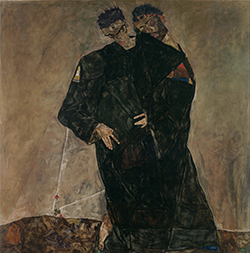Gustav Klimt and Egon Schiele confronted the modern condition in Vienna at the turn of the century in their unique artworks. The crises faced by the modern Viennese were manifold. Klimt responded by exposing the true face of civilization and progress and resorting to erotically-charged Art Nouveau-esque decorativeness. In his fantasy, art was omnipresent in beautiful abstracted patterns and shimmering gold. Egon Schiele antagonized the anxiety felt by many in what he called the ‘black city’[1] through the exposition of the disgust and allure of the human body. His fantastic world penetrated into the privacy of not only his models and himself, but also that of the viewer.
Klimt’s The Kiss and Schiele’s Cardinal and Nun
Cardinal and Nun is an obvious paraphrase of Klimt’s The Kiss. Schiele borrowed the composition of an embracing couple. In both paintings, the couples merged into an undistinguishable double figure symbolizing sexual passion and consummation. However, while Klimt’s pair unified in complete harmony, Schiele’s couple overturns this by featuring the nun as the sexual female. Here, he engaged the viewer in an emotionally charged battle of the sexes with the nun gazing out nervously as if caught in the act. The shocking notion of sexual scandal in the cloisters was fully exposed. Klimt’s golden splendor and Schiele’s cubist inspired geometry brought the viewer to the surface, albeit for different reasons. While Klimt sought for the purely aesthetic language in abstract forms, Schiele exaggerated the contrast between the intensely colored figural forms with representational physiognomies for dramatic expression.
Klimt’s Death and Life and Schiele’s Selbstseher II (Death and Man)
With a series of assassination of public figures and increasing suicides, death became a dominant motif in Vienna at the turn of the century. Preoccupied with the solemn topic, Klimt and Schiele presented their vision of death in profoundly different ways. Using his customary decorative style, Klimt presented people of different social types as being equal in the face of death. Gathered in a mass, the group of individuals symbolizes mankind arranged like the crowds in his Faculty Paintings. However, each individual also withdraws into their own reverie, highlighting their individuality even as they are amassed together sharing the same fate. The lack of communication between mankind and the allegorical figure of death creates a tension which is emphasized by the space between the two groups. It conveys a sense that these people are ignorant of their impending death and appearing almost dreamlike, not fully formed by the realization of the reality of death. In such beautiful forms, it reminds us of Klimt’s contemporary, the well-known writer, Rainer Maria Rilke who wrote, “For the Beautiful is nothing but the onset of that Terror we can scarcely endure.”
Death for Schiele is not an external force but rather the antithesis of the self. Schiele literally anticipated the psychological concept of an unconscious self, as espoused later by Freud, which was then developing.[i] The double, the Doppelgänger, seizes onto his other self who seems unaware. Schiele explains his idea, “If I look at myself as a whole, I shall have to see myself, to know what I want myself, what is not only happening within me but the extent to which I possess the ability to see, which means are mine, from which mysterious substances I have been formed, out of how much more of that, what I recognize, what insights I have gained into myself up to this time.” The psychological intensity was heightened by the garish green and orange on the face and body of the man and the blurriness of the figure harbinger of death.
Klimt and Schiele Now
What do Klimt and Schiele mean to us now? The consumer culture of the 1980s adopted the luxurious imagery of Klimt as popular icons of a postmodern decorative style. Schiele’s art appeals to us with the figures’ provocative gesture and contorted bodies. They have remained important works because they speak to us aesthetically. Both men controlled their use of colors with incredible finesse; their lines convey a precision without abandoning spirit. They have transcended the confines of history. In recent years, the two artists have received renewed interests as scholars seek to place these men in a broader historical context. Celebrations of Klimt’s 150th anniversary in 2012 saw numerous exhibitions. But their relevancy is more than a ripple in history. There are parallels. In our consumerist society, and particularly in Asia today, the façade of wealth that dominate our experience of a shinny bright city belies greater social concerns of a financial crisis, natural disasters, and a post 9/11 world. Questions about sexuality and morality, death and life, and modernity and progress meant as much to the fin-de-siècle Viennese as they do today. These two artists, who are now recognized as masters, were in their days seen as idiosyncratic men who pursued their art with intensity and passion. Perhaps that is their most enduring gift to us today. At times of crises, fantasies are more than escapes for they provide a playground where difficult questions can be asked and make us face reality with an enduring honesty.




